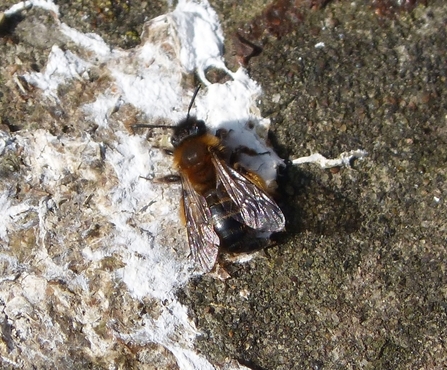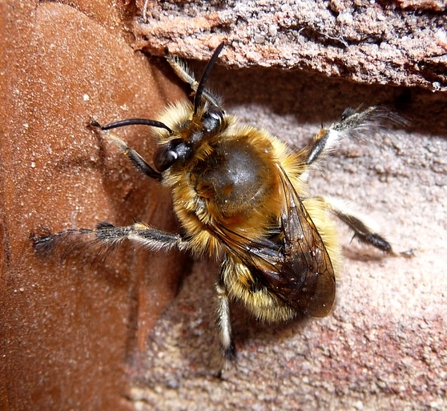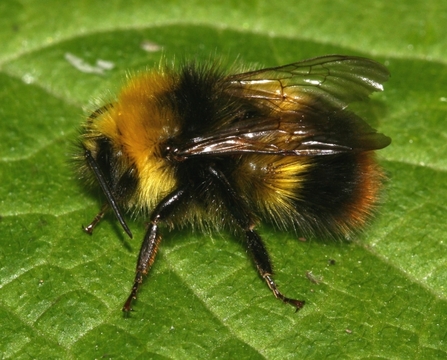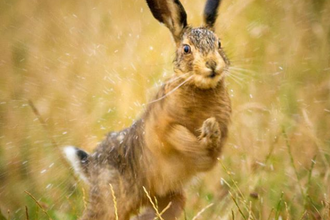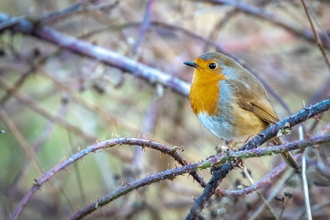From huge, fuzzy bumblebee queens to pint-sized solitary bees, here are 11 early spring bees to look out for on your next trip outdoors.
Spring bees: Which species are on the wing first?
Catherine Ingham
Spring solitary bees
Spring bees in the UK aren’t just bumblebees; many of the early risers are solitary bees. As their name suggests, these species lead solitary lives rather than living in a multi-bee nest. They dig their own burrow and live in it alone. Depending on the species, a solitary bee nest can be found everywhere from holes in the ground and sandy banks to gaps in walls, special ‘bee houses’ and even old snail shells. But don’t worry about your walls; solitary bees won’t sting and are incredibly important pollinators of flowers, fruit trees and crops like oil-seed rape.
These are some of the most common spring solitary bees you are likely to see in our region.
Early mining bee (Andrena haemorrhoa)
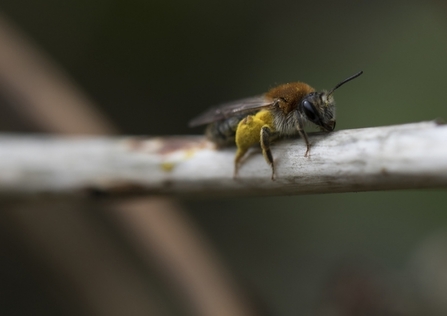
Chris Lawrence
This is one of the earliest solitary bees to emerge and can be active from March until June. They are very small, and females can be identified by a dark red tip on their abdomen plus a covering of foxy hairs on their back.
Early mining bees are really common across our region and can be found in a diverse range of habitats, from parks to quarries. They adore willow catkins but also feed on a wide variety of wildflowers, including dandelions! These are a fantastic source of early pollen for a number of bees, so please think about leaving them to grow in your garden.
Tawny mining bee (Andrena fulva)
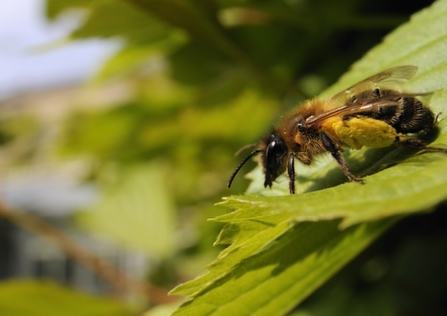
Nick Upton/2020VISION
Gwynne’s mining bee (Andrena bicolor)
Gwynne’s mining bee is a tricksy little Andrena that can be hard to tell apart from other mining bees. It is one of our most versatile solitary bees, setting up home in almost any habitat and feeding from countless flowers and blossoming shrubs when it is on the wing from March until June. Keep your eyes peeled when you walk past dandelions, daisies, coltsfoot, lesser celandine, wood anemone, forget-me-nots, brambles and more!
Ashy mining bee (Andrena cineraria)
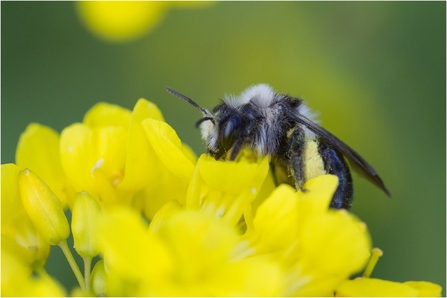
Sarah Marshall
There is no mistaking the smoky grey bands of this beautiful bee. It generally flies from March until June and, like the tawny mining bee, makes little volcanoes of earth in the ground when it creates a burrow. When it rains or the bee has finished foraging for the day, it closes over the entrance to this burrow and seals itself inside.
Some of the ashy mining bees most common food plants are willow, gorse, blackthorn, hawthorn, buttercup and thrift.
Hairy-footed flower bee (Anthophora plumipes)
These wonderful bees are amongst the first to appear in spring, with males emerging as early as late February. But you need to be lucky to spot one; whilst common in the south of the UK they are very local up north, with Liverpool, Mawdesley and Blackpool holding the only records in our region. You are most likely to find them feeding on lungwort, comfrey, ground-ivy, dead-nettles and primroses with their exceptionally long tongues!
Male hairy-footed flower bees do indeed have very hairy little feet. They are also incredibly territorial and will protect their own small patch of flowers.
Spring Bumblebees
Did you know that queen bumblebees are the only members of the colony that survive the winter? They emerge in spring to gorge on early nectar and pollen before hunting out a nest site (usually a hole in the ground or abandoned small mammal burrow) where they will raise a brand new generation. These huge queens will be among the first bumblebees you see as spring arrives, and will usually be one of a handful of species.
White-tailed bumblebee (Bombus lucorum)
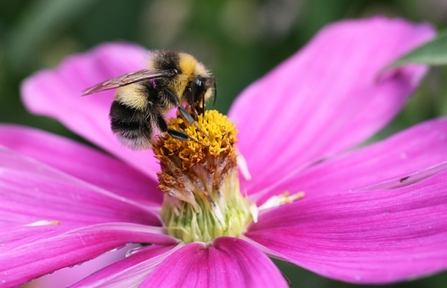
Penny Frith
Often the earliest active bumblebee, white-tailed bumblebees are one of our most common and recognisable bumbles. They are striped black and yellow – one yellow stripe on the thorax and one on the abdomen – with a white tail. The queens usually appear from March, with workers following in April when they will diligently go about foraging from spring-blooming flowers and shrubs, particularly sallows and blossoms. You can see them almost anywhere, from woodlands to farmland to gardens.
Buff-tailed bumblebee (Bombus terrestris)
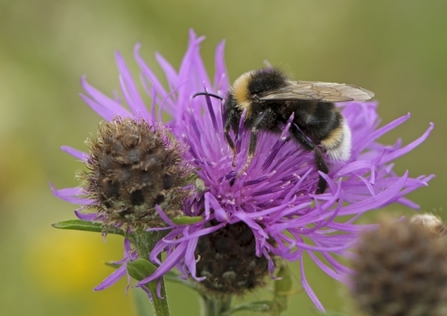
Chris Gomersall
The buff-tailed bumblebee could easily be mistaken for the white-tailed bumblebee, but look closely and you’ll see that it’s bands are more orange than bright yellow. Queen buff-tailed bumblebees tend to have a more orange-tinted tail, while some males also have a very slim buff-band at the top of the tail. Workers, on the other hand, can be virtually impossible to tell apart from white-tailed bumblebees without gene testing – very confusing!
You’ll see these bees on the wing from February to as late as October in two generations, where they will turn up anywhere their food sources are abundant. Blossom trees and flowers like gorse, daffodils, crocuses and bluebells are favourites.
Early bumblebee (Bombus pratorum)
One of our smaller Bombus species is also one of the loveliest. The early bumblebee has one yellow band on its thorax and one on its abdomen (though this one may sometimes be absent), as well as beautiful orange tail. Males are particularly dumpy and have a lovely yellow covering of hair on their heads.
The early bumblebee lives up to its name, emerging around March and April and flying into October, usually after the birth of a second generation. They love woodlands as well as gardens, where they feed on coltsfoot, dandelions, dead-nettles and sallows.
Tree bumblebee (Bombus hypnorum)
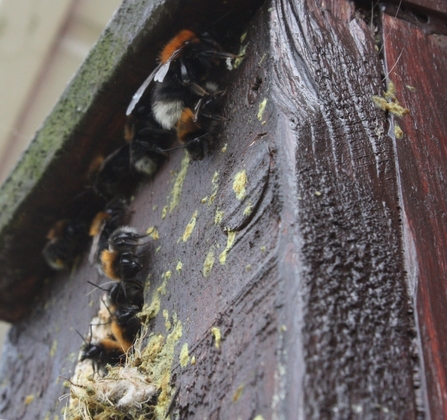
Alan Wright
The tree bumblebee is a fascinating little insect that wasn’t seen in the UK until the year 2000. It can now be found in almost every county of England and Wales and is among our most common bumblebees.
Despite their name, tree bumblebees are more commonly found nesting in bird boxes than tree holes, though they do still live in these woodland cavities. They are a great bee for beginners to identify, with queens, workers and males all boasting a distinctive orange thorax and white tail. Queens typically appear in March to feed on blossoms, sallows, white dead-nettle and garden cotoneasters everywhere from woodlands to gardens and allotments.
Red-tailed bumblebee (Bombus lapidarius)
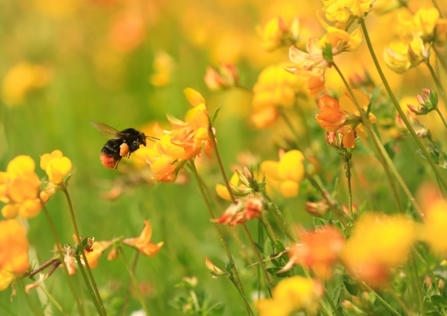
Jon Hawkins - Surrey Hills Photography
You can’t miss the jet-black body and fiery orange tail of the red-tailed bumblebee as it feeds on dandelions and white and red dead-nettles. It typically flies from March to August – though new queens can push on into October – and can be seen buzzing between flowers in a wide variety of both rural and urban habitats. Grassland brimming with white clover is a sure-fire red-tailed bumblebee hotspot.
Bilberry bumblebee (Bombus monticola)
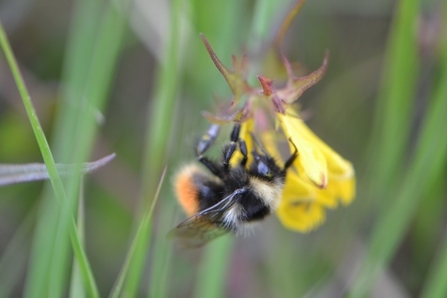
Peter Gravett
Thought not as common in Lancashire as North Wales and Scotland, the bilberry bumblebee (also known as the blaeberry bumblebee) is widespread in the Lancashire uplands, particularly where there is plenty of willow and bilberry to feed on. It has even been recorded several times from Hilbre Island off Wirral; an unusual occurrence at sea level. Queens emerge from late March onwards and look similar to early bumblebee queens, though are rounder and have much more orange on their abdomen.
Thought not as common in Lancashire as North Wales and Scotland, the bilberry bumblebee (also known as the blaeberry bumblebee) is widespread in the Lancashire uplands, particularly where there is plenty of willow and bilberry to feed on. It has even been recorded several times from Hilbre Island off Wirral; an unusual occurrence at sea level. Queens emerge from late March onwards and look similar to early bumblebee queens, though are rounder and have much more orange on their abdomen.


